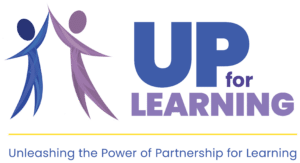How can I expedite my school’s shift to youth-adult partnership?
UP has been working for years to help youth-adult teams hone their partnerships. We recognize the teeter-totter effect, where one generation or the other may end up with an outsized share of power and leave the other hanging. We know it takes time to get to four feet on the ground, the balanced sharing of responsibility and power that makes youth-adult partnership most effective. For those engaged in this challenging paradigm shift, here are a few of the lessons we’ve learned and some accompanying tools.
- Help both youth and adults understand the WHY of the change to youth-adult partnership, creating a shared vision for this destination. Shifting mental models of roles and responsibilities is key to implementing personalized and proficiency-based learning. Yet we have observed that many students, and also educators, feel that this is simply a new method being imposed on them. They do not completely understand the necessity of shifting relationship norms to realize the full potential of these practices. Additionally, when people not familiar with education jargon hear youth voice and choice or personalized learning or student-centered learning the youth dominated model is often what they assume is the suggested change – and react negatively in response. The What’s the Deal with Proficiency-based Learning video is a helpful tool to explore the why of change, and seed a discussion about the changes necessary. Linking the reasons for personalized learning to brain-based research has also proven to be an effective way to address concerns.
- Help people understand the destination and the incremental steps to that end. Provide a Roadmap to introduce the broad concepts of the youth-adult partnership journey, naming the core variables that must shift along the way. Create dialogue about the change in roles and responsibilities, openly exploring the pros and cons, challenges and opportunities. This shared understanding and language for the process of change can serve as an ongoing touchstone to expedite the paradigm shift. UP has created the Youth-Adult Partnership Roadmap rubric which may be helpful in this regard. Additionally, the Taking the Pulse of Partnership rubric is a tool to help teams monitor the meeting and task management process.
- Create community commitments or norms that reflect partnership…and then embed these norms into the fabric of the team’s relationships. The easiest way to expedite the teeter-totter recalibration process is to establish a safe environment to co-create norms that support partnership, beginning with trust, respect and equity of voice. Once these norms have been agreed upon by both youth and adults, they must be referenced regularly. There must also be an allowance for inadvertently reverting back to old patterns, and an agreed-upon means of gentle reminders to put the group back on track. As previously noted, this is anything but a linear or simple process! Mistakes are often a catalyst for the most poignant moments of growth, as new norms take root. UP frequently weaves in Margaret Wheatley’s poem Turning to One Another as a component of deciding upon these new inclusive and empowering principles and practices.
Four feet on the ground:
The promise of balancing the teeter-totter
- Students understand the importance of their role in learning, sparking ownership and engagement.
- Teachers can focus more on facilitating learning and less on behavior management; time previously consumed by a power dynamic (eg. make me learn) is replaced by learning itself.
- Academic performance increases setting off the cascade of positive ripples that come with academic success
- There is renewed hope when both adults and youth know that they matter – to each other, and to the learning and school change process itself.
- There is equity in access to engaging learning, where each and every young person believes in their capacity and agency in the world.
Imbued with purpose and hope, youth-adult partnership brings out our best selves.All parties are fully empowered to work in community toward a shared goal. In the words of Margaret Wheatley:
There is no power greater than a community discovering what it cares about.

